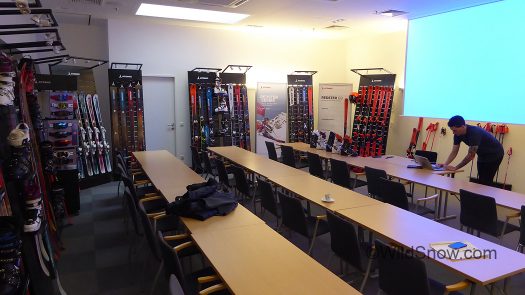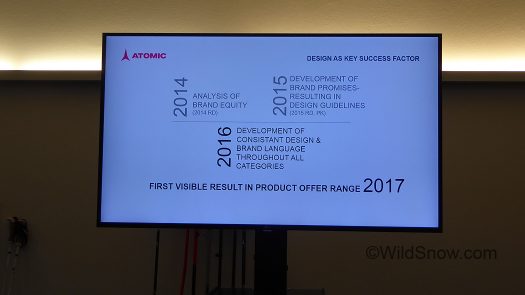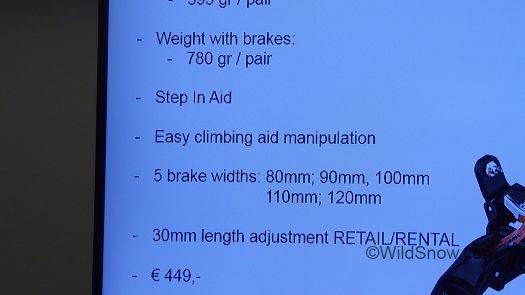After a nice stop in Italy during my EU wanders a few weeks ago, I grabbed a series of four trains back north to Austria. The journey took all day and challenged my adventure travel skills (if not taxing my emotional intelligence), but I got it done. Specifically, visit Atomic ski company HQ at Altenmarkt.
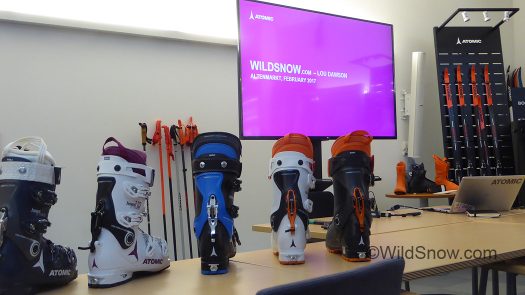
I’m intimidated when they have a presentation just for WildSnow. Perhaps that’s the idea? These guys are too nice for that. But wait, they’re all x-maddog ski racers who take no prisoners. Figures, they were not messing around here, but we got a lot of laughs along the way.
Atomic is known for what I’m told is the largest ski factory in the world — with nearby ski slopes such as Flachau, where 2-plank legends such as Hermann Maier refined their game. With ski touring being the only expanding market in glisse snowsports, Atomic is doing what comes naturally to any business. They’re clearly trying for their share of the pie.
While I’m a fan of the more “niche” ski touring gear makers out there, big guys entering the fray has advantages for all of us. Prices might go down, and could quality actually go up? On the other hand, we risk an oversupply situation with reduced profits and thus reduced funds for innovation. We shall see.
Meanwhile, while Atomic is no doubt the big guy, they’ve segmented out their ski touring product development to a spirited group who practice what they preach. Result, nice gear that’s fun to write about and terrific to ski on.
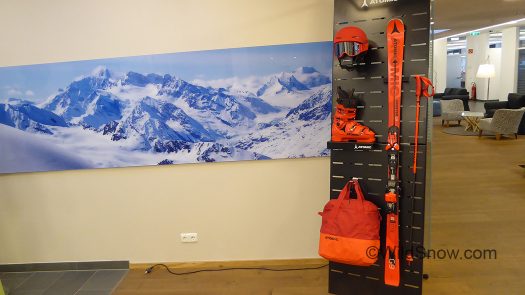
When you walk in the door of Atomic HQ you are in the land of Redster, on the alpine side anyway. I like their integrated design philosophy. More, I like the performance I’m told by users is ubiquitous across the entire Atomic line. I’m not quite ready to test Marcel Hirscher’s skis, so I’ll take this at face value.
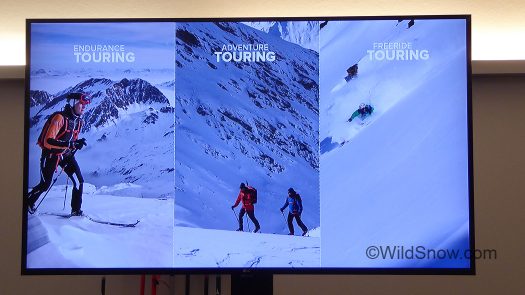
Atomic divides their ski touring lineup into three categories: “Endurance” includes speedy lightweight backcountry action as well as resort uphilling. “Adventure” is what most of us do in the backcountry. “Freeride” is that ever elusive market that always seems just beyond the grasp of any one company’s 130 flex boots. As of next season, Atomic (along with sister company Salomon) will have products for nearly the full range, with the exception of a race binding (rumoured to be coming). Freeride binding is taken care of by Atomic Tracker, which works with both alpine and ISO 9523 ski touring boots that have WTR soles.
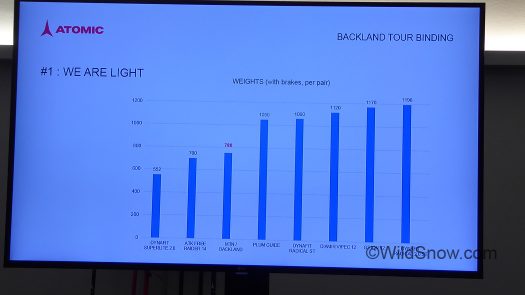
I’ve covered the Backland-MTN binding quite a bit now, but let’s throw in a few more views. One of the kudos is relativly light weight, but let’s not forgot that most of these bindings have fully adjustable release rather than only a couple of swap springs.
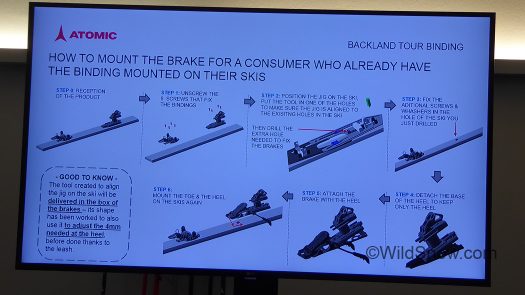
Instructions published by Atomic for mounting Backland brake, using the jig alignment tool in next photo.
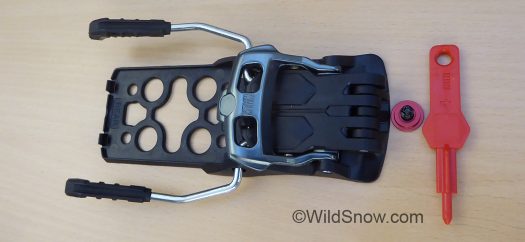
Brake with the additional screw, stud, and jig alignment tool (doubles as a 4 mm spacer gauge for setting boot heel “tech” gap).
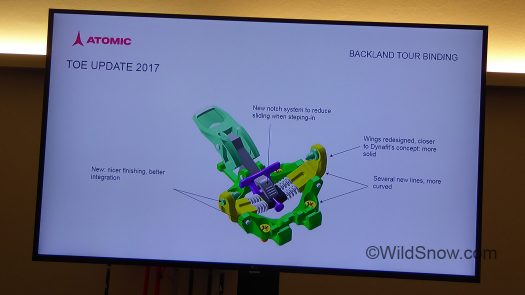
The binding is indeed improved for 2017-2018. Mainly, improved closing trigger and wing arms that are forged instead of machined, said to be stronger, slightly lighter, and help keep costs down. By the way, I’m told that 40 mm is an industry informal “norm” for binding reinforcement in the ski, and subsequent width of binding toe screw pattern. Backland-MTN toe screws are 40 mm apart.
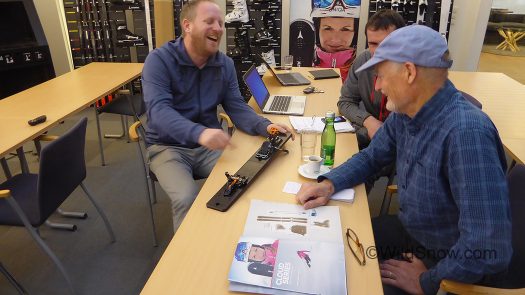
Getting the line from Atomic binding Product Manager Ralf Schoerghofer. He’s of course working in conjunction with Salomon on the entire Backland-MTN binding project which they call “shared development.” Takeaway here is these guys seem to get it. They acknowledge weight is an issue, seem to be looking for max durability, and wow that brake system that’s divorced from the heel unit is just plain intelligent. Forgive me if I sound like a broken record, but it’s worth repeating that the most amazing thing about the binding is here we have the powers of ski gear development doing ski touring tech, and they opt for the 30+ year old swap-spring configuration invented by Fritz Barthel. I’m now thinking that Barthel’s invention is nothing less than the automobile wheel of ski touring. It simply will not go away, at least until we have skis with levitation.
It’s here I should reiterate the main disadvantage of “U-spring” touring bindings such as Backland-MTN: You can’t fine-tune the release adjustment, nor can you adjust vertical release independently from lateral. Instead you’re at the mercy of how the manufacturer wants to build and supply the springs. But, is that so bad? Reality of tech bindings is that even those that conform to the DIN/ISO touring binding standard allow quite a bit of variation in the actual release tension as compared to what’s printed on the binding. What is more, very few people fine-tune their touring binding release, opting instead to dial their settings higher than “chart” to help prevent accidental release that can be life threatening rather than simply limb injuring.
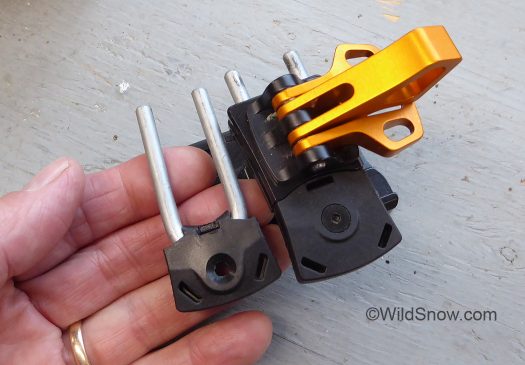
As we have lots of newcomers to backcountry skiing dropping by here, I thought I’d throw in this photo of exactly what an Atomic Backland “U-spring” looks like. The “tuning fork” ends insert into the heel of the boot. See this FAQ for an ongoing dissertation founded by the venerable U-spring binding.
Me, I’d prefer that the Backland-MTN binding had one more spring that was between the “Men” and “Women” in release value, as the “Men” spring is too strong for me and the “Women” too weak. Further, perhaps yet another spring could be supplied for “Child.”
Both Atomic and Salomon are leery of spouting “DIN” numbers regarding their swap springs. I can say that the “Expert” spring is probably around 11, while the “Men” is around 8, the “Women” around 6. As with all tech bindings, actual release value is also dependent of wear of boot toe fittings and the exact heel gap that exists at the time of release.
It was a long meeting. Boots are next. Availability of Backland binding appears to be spotty, check the usual suspects, and know that both the Atomic and Salomon versions should be widely available come fall of 2017.
WildSnow.com publisher emeritus and founder Lou (Louis Dawson) has a 50+ years career in climbing, backcountry skiing and ski mountaineering. He was the first person in history to ski down all 54 Colorado 14,000-foot peaks, has authored numerous books about about backcountry skiing, and has skied from the summit of Denali in Alaska, North America’s highest mountain.

